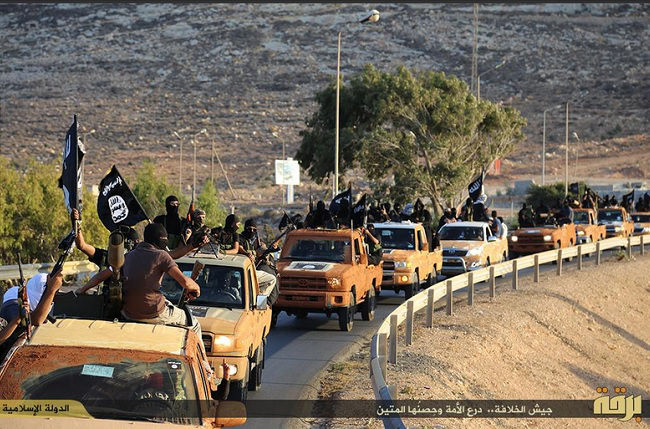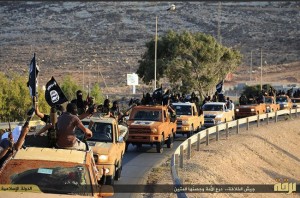By Mawassi Lahcen
in Casablanca for Magharebia
Islamic State supporters parade through eastern Libya (Barqa) in this photo posted online November 16th, 2014. Daesh cells are also cropping up in Morocco.
Islamic State supporters parade through eastern Libya (Barqa) in this photo posted online November 16th, 2014. Daesh cells are also cropping up in Morocco.
The emergence of Islamic State cells in northern Morocco has local residents wondering if a region known for tolerance will be the next epicentre for terrorism.
Islamic State (ISIS) followers recently vowed to slaughter fellow Moroccans, but security forces found them before they could act on their threat.
The latest cell’s homemade video, “Appearance of Caliphate Soldiers in Maghreb Al-Aqsa”, appeared November 18th on YouTube.
Two of the masked men in the video waved an ISIS flag and the third held a sword. Swearing allegiance to Daesh leader Abu Bakr al-Baghdadi, they threatened a bloodbath in the kingdom.
The video attracted broad attention. In the short time that it was available online, thousands viewed the clip and posted comments.
One terrorist shown in the video called for support from “the lions of north and south, west and east in general, and the residents of Berkane in particular”.
The video appeared just days after al-Baghdadi released an audio recording urging his followers to declare war on “the sons of secularism”, meaning all Muslims who differed from Daesh.
But the media buzz soon shifted from the jihadist trio to the Moroccan security officers who caught them. Four days after the video was released, the terrorists were tracked down and arrested in Berkane, near the Algeria border.
Moroccans welcomed the news about the capture as evidence that the interior ministry’s new “Hadar” counter-terrorism strategy was working.
“Al-Baghdadi’s audio message was actually a desperate distress call because of the blows and setbacks Daesh is suffering in Syria and Iraq,” taxi driver Anflous Abdelali tells Magharebia. “And the fall of his followers, who appeared in the video, with such speed at the hands of Moroccan justice, is proof that the group has no prospects here,” he says.
“The proverb that says a drowned person held onto another drowning person applies to them,” Abdelali adds.
But according to political analyst Lahcen Oussimouh, ISIS threats should be taken seriously.
“The high level of alert and security vigilance that Morocco has witnessed since early November indicates that the Moroccan security authorities are quite aware of these dangers,” he says.
The terrorist threat has taken on an unprecedented dimension with the appearance of Daesh, the analyst adds.
“We’re now about to see a new wave of bloodier and fiercer ‘lone wolves’ than anything known before,” Oussimouh warns. “These new lone wolves have been recruited and trained via social networking websites and have received strict instructions, making the task of security agencies in identifying them more complex and difficult.”
But if Daesh turns to the “lone wolf” model, it will actually be copying al-Qaeda. Adil Othmani received the death sentence for the April 28th, 2011 explosion at the popular Argana café on Djemaa El Fna square, the first such lone wolf operation in Morocco.
The al-Qaeda attack in Marrakech killed 17 people, mostly foreign tourists.
Oussimouh expects that ISIS followers will also “try to target public figures, tourists, strategic facilities and foreign interests, as well as ethnic and religious minorities, especially Moroccan Jews, Christians and Amazigh activists”.
The fear that Daesh could strike minorities is not unfounded. “All terrorist experiences that Morocco has seen since 2003 show that minorities and foreign tourists are the number one target of terrorist attacks,” he tells Magharebia.
“The 2003 Casablanca bombings targeted the Israeli community building, the ancient Jewish cemetery, the Positano restaurant near the Belgium embassy and the Casa de España club. In 2007, two simultaneous bombings targeted the US Consulate in Casablanca and the American Cultural Centre,” Oussimouh recounts.
It is not just old news. Since the beginning of this year, he says, Salafist Jihadist sheikhs in Morocco have “issued several fatwas accusing Amazigh activists of apostasy, in what is seen as incitement to kill them”.
A Jewish community leader for the Fès-Oujda-Sefrou region disagrees, saying that Daesh does not differentiate between Muslims or Jews, Arabs or Amazighs.
“ISIS doesn’t pose a distinct threat to a certain group of people or a single ethnic or religious sect; rather, it is a threat to every free man, regardless of his religion or beliefs, and to every tolerant democratic person, including Muslims,” says Armand Guigui, head of the Committees of Jewish Communities.
“Its followers are slaughtering everyone in Syria and Iraq, and none, whether Arabs, Kurds, Sunnis, Shias, moderate Islamists or even radical al-Qaeda Islamists who share the same ideology, have been spared,” the Jewish leader adds. “Therefore, Moroccan Jews don’t feel there is a distinct threat against them; they’re as threatened as any other Moroccan citizen of any sect, religion or ethnicity.”
Ethnic and religious violence is foreign to the region, according to Bekkouche Abdessamad, an agricultural engineer in Berkane. He voices surprise that ISIS would appear in an area known for its religious tolerance and the centuries-long co-existence of the three religions.
“Oujda is famous for the St. Louis historical church. It is the only church in the world that shares with a mosque the same garden and same façade on the same street,” he says. “Not far away, the Sidi Yahya Benghazi Younis shrine is visited by the followers of the three religions: Jews, Muslims and Christians.”
“Real Islam has nothing to do with what those terrorists are promoting,” Abdessamad adds.
Amazigh activist Boubaker Ounghir agrees that ISIS targets everyone, but says that minorities face the greatest risk. “It’s true that no sect has been spared the repression and brutality of ISIS in Iraq and Syria, but violence against Kurds, Yazidis and Christians has surpassed all similar historical events,” he says.
“ISIS has committed the most gruesome form of genocide against those people, and we have seen unimaginable forms of repression, brutality and hatred by ISIS against minorities. This in addition to taking children and women as slaves, and dragging humanity back to the old era of slavery,” the Amazhigi adds.
“We’re today facing a comprehensive terrorist threat of a new type; terrorist operations have seen a new shift at the hands of ISIS which has made violence and spread of terror a pure goal of its activities,” says Mohamed Benhammou, the president of the Moroccan Centre for Strategic Studies (CMES).
Killing and bloodshed have become an addiction for the Daesh followers, he says, as can be seen in the videos they post from Syria and Iraq.
“There is also a change in the means used by the terrorists in their operations,” he adds. “ISIS terrorists don’t just use all types of weapons and explosives; they use anything that can inflict harm on others. A terrorist can hijack a car, drive it at maximum speed and get it onto a sidewalk to run over and kill as many people as possible,” the CMES head points out.
Just as co-ordination among security and intelligence agencies around the world becomes more necessary than ever, confronting ISIS requires efforts from all, Benhammou tells Magharebia.
“These changes in terrorist behaviour now require the involvement of citizens,” Benhammou adds. “Everyone, not just security agencies, must be vigilant and alert; ISIS and its followers are thirsty for blood and for spreading terror in an unprecedented way.”








